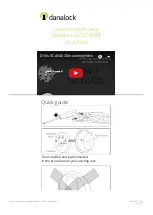
© velorian GmbH, Storkower Str. 115A, 10407 Berlin, Germany
email: support@velorian.de - fon +49 (0) 30 3643 1679
Version DE. 01.2021.05.11
Rear indicator
First, the indicator bracket for the rear turn signals should be mounted on the bike and the turn signals mounted on the bracket. Now
the 4-wire cable can be routed to the mounting position of the rear turn signals, shortened to the correct length, the cable ends
stripped and fitted with flat plug sleeves. Similarly, the connecting cables of the turn signals are shortened to the correct length and the
cable ends are stripped and fitted with flat plugs.
Once the rear turn signals are connected, the connection to the power supply can be re-established and a final function test carried
out.
Mounting finish
At the end of assembly, the position of the switches and indicators should be checked and all screw connections tightened. The
remains of the cables and the cable ties can be disposed of in the residual waste.
Function and operating instructions
The function complies with the requirements of the StVZO (Germany) and UN ECE 50.
Operation with indicator switch (toggle switch)
When the toggle switch is mounted on an appropriately configured blinkerbox triggers flipping the toggle switch to the left the turn
signals to flash on the left side. When the switch is returned to its original position the flashing stops.
Flipping the toggle switch to the right causes the indicators on the right to flash.
If the switch is not returned to the home position,
the flashing stops automatically after 2 minutes
. Returning the toggle switch to its
original position and switching it on again will restart the flashing.
Triggering the hazard warning lights is not possible with the toggle switch.
Operation with buttons
When the push-buttons are mounted on an appropriately configured blinkerbox triggers a short press on the left push-button flashing
of the turn signals on the left side. If the left button is pressed again, the left turn signals stop flashing. Pressing the button on the right
side causes the indicators on the right side to flash. If the right button is pressed again, the flashing stops. Switching the flashing from
e.g. left to right can be achieved by pressing the other button in each case.
If the indicators are not switched off manually,
the flashing stops automatically after 2 minutes.
The hazard warning lights are triggered by switching on the other side. Pressing and holding one button and pressing the other button
starts the warning flashing. It can be stopped again by pressing one of the buttons.
The warning flashing stops automatically after 30 minutes.
Warning function in case of failure of one of the turn signals (only with configuration for 4 turn signals)
If, for example, one of the rear turn signals fails:
- The front indicator flashes twice as fast. If the front indicator fails, the rear indicator flashes twice as fast.
- The separate status LED (if installed) flashes twice as fast.
- The sound generator in the flasher unit (if active) ticks twice as fast.
Configuration of the Blinkerbox
The indicator box can be configured for different operating modes. The push-buttons or a corresponding device and a connection to
the power supply are necessary for configuration.
The configuration is started by holding down one indicator button and pressing the other button eight times, then releasing both
buttons. After 2 seconds, the indicator is in configuration mode and the software version can be set by pressing three more buttons.
The following is an overview of which button presses determine which setting:
1st button press: number of installed turn signals:
left button = 2 turn signals,
right button = 4 turn signals.
2nd keystroke:
button or switch operation,
left button = push button,
right button = switch
3rd button press: indicator sound on or off,
left button = indicator sound off,
right button = sound on
This results in the following key combinations to select the software versions in configuration mode:
L designates the left button, R the right button:
2 indicators switch with sound
LRR
4 indicators switch with sound
RRR
2 indicators button with sound
LLR
4 indicators button with sound
RLR
2 indicators switch without sound
LRL
4 indicators switch without sound
RRL
2 indicators button without sound
LLL
4 indicators button without sound
RLL
After entering the key combination, the configuration is completed.
The configuration is retained even after disconnection from the power supply.
Subject to technical changes.






















